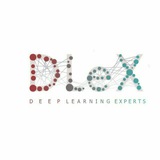Top Resoures Deep learning Reading List
#deeplearning #Data
🌎 Link Review
🌎 Most Cited Deep Learning Papers
🌎 Understanding CNNs Part 3
🌎 Understanding CNNs Part 2
🌎 Understanding CNNs Part 1
🌎 23 Deep Learning Papers To Get You Started
🌎 Deep learning Reading List
✴️ @AI_Python_EN
🗣 @AI_Python_arXiv
❇️ @AI_Python
#deeplearning #Data
🌎 Link Review
🌎 Most Cited Deep Learning Papers
🌎 Understanding CNNs Part 3
🌎 Understanding CNNs Part 2
🌎 Understanding CNNs Part 1
🌎 23 Deep Learning Papers To Get You Started
🌎 Deep learning Reading List
✴️ @AI_Python_EN
🗣 @AI_Python_arXiv
❇️ @AI_Python
Kaggle kernels that Researcher have published.
1. Time Series Analysis - Artificial Neural Networks - https://lnkd.in/f8diQkX
2. Titanic - Data Preprocessing and Visualization - https://lnkd.in/fwrvHr5
3. Everything you can do with Seaborn - https://lnkd.in/fpgQCr8
4. Insights of Kaggle ML and DS Survey - https://lnkd.in/fPyiGyU
5. Time Series Analysis - ARIMA model - https://lnkd.in/fn24ihz
6. Time Series Analysis - LSTM - https://lnkd.in/fuY6DXm
7. Introduction to Regression - Complete Analysis - https://lnkd.in/fM3xsZ2
8. Time Series - Preprocessing to Modelling - https://lnkd.in/fJcar4u
Kaggle community is one of the best community for Data Science.
#machinelearning #artificialintelligence #datascience #deeplearning #data
✴️ @AI_Python_EN
🗣 @AI_Python_arXiv
❇️ @AI_Python
1. Time Series Analysis - Artificial Neural Networks - https://lnkd.in/f8diQkX
2. Titanic - Data Preprocessing and Visualization - https://lnkd.in/fwrvHr5
3. Everything you can do with Seaborn - https://lnkd.in/fpgQCr8
4. Insights of Kaggle ML and DS Survey - https://lnkd.in/fPyiGyU
5. Time Series Analysis - ARIMA model - https://lnkd.in/fn24ihz
6. Time Series Analysis - LSTM - https://lnkd.in/fuY6DXm
7. Introduction to Regression - Complete Analysis - https://lnkd.in/fM3xsZ2
8. Time Series - Preprocessing to Modelling - https://lnkd.in/fJcar4u
Kaggle community is one of the best community for Data Science.
#machinelearning #artificialintelligence #datascience #deeplearning #data
✴️ @AI_Python_EN
🗣 @AI_Python_arXiv
❇️ @AI_Python
How would a rockstar 🎸would improve their machine learning models?
چگونه مدلهای یادگیری ماشین را بهبود دهیم؟
To get better at playing the guitar, you play the guitar more. You try different songs, different cords. Practice, practice, practice.
All the practice adds up to more experience, more examples of different notes.
And to try something totally different, you might merge two songs together. Or even take a song written originally for the piano but play it on your guitar.
After a while, you're ready to play a show. But the show won't some any good if all the speakers are set to different settings. Steve the sound guy takes care of this.
How does this relate #machinelearning?
1. More practice = more data
More examples of playing different notes = more data. Machine learning models love more data.
2. Combining different songs = feature engineering
If the #data you have isn't in the form you want, transforming into a different shape may be a better way of looking at it.
3. Tuning the speakers = hyperparameter tuning
There's a reason tuning the speakers is the last step in playing a rock show. Working speakers don't mean anything without all the practice (collecting data) and songwriting (feature engineering). If you've done 1 and 2 right, this is the easy part.
🗣 @AI_Python_Arxiv
✴️ @AI_Python_EN
چگونه مدلهای یادگیری ماشین را بهبود دهیم؟
To get better at playing the guitar, you play the guitar more. You try different songs, different cords. Practice, practice, practice.
All the practice adds up to more experience, more examples of different notes.
And to try something totally different, you might merge two songs together. Or even take a song written originally for the piano but play it on your guitar.
After a while, you're ready to play a show. But the show won't some any good if all the speakers are set to different settings. Steve the sound guy takes care of this.
How does this relate #machinelearning?
1. More practice = more data
More examples of playing different notes = more data. Machine learning models love more data.
2. Combining different songs = feature engineering
If the #data you have isn't in the form you want, transforming into a different shape may be a better way of looking at it.
3. Tuning the speakers = hyperparameter tuning
There's a reason tuning the speakers is the last step in playing a rock show. Working speakers don't mean anything without all the practice (collecting data) and songwriting (feature engineering). If you've done 1 and 2 right, this is the easy part.
🗣 @AI_Python_Arxiv
✴️ @AI_Python_EN
How do you detect outliers in #data?
Do you use a blanket rule of anything outside 3 standard deviations?
Or do you use a more robust method?
If you have a resource you learned from or one you created. I'd love to reference it in my article on exploratory data analysis.
If you want to read it, there's a link in the comments. #EDA is one of the areas I've learned the most over the past year.
I remember things best if I write about them. So that's what I did.
PS There's more pretty pictures like this one in there too 🎨
#datascience
🗣 @AI_Python_Arxiv
✴️ @AI_Python_EN
Do you use a blanket rule of anything outside 3 standard deviations?
Or do you use a more robust method?
If you have a resource you learned from or one you created. I'd love to reference it in my article on exploratory data analysis.
If you want to read it, there's a link in the comments. #EDA is one of the areas I've learned the most over the past year.
I remember things best if I write about them. So that's what I did.
PS There's more pretty pictures like this one in there too 🎨
#datascience
🗣 @AI_Python_Arxiv
✴️ @AI_Python_EN
